REPRODUCTION
Stamen, Carpel, Petals, Sepals, What Is Pollination?, Animal-Pollinated Plants, Wind-Pollinated Plants
Flowers come in many shapes, colors, and sizes. They are a plant's reproductive organs. They usually contain both male and female sex organs. Some major parts are shown below.
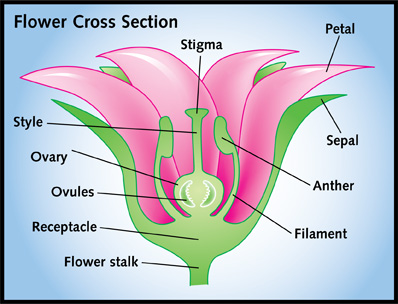 Look inside a real flower and try to match all of the parts inside it with the picture here.
Look inside a real flower and try to match all of the parts inside it with the picture here.
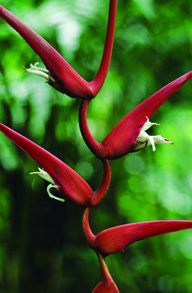 Not all flowers look the same, but most of them contain the same parts. It is harder to find each part in a plant like this though!
Not all flowers look the same, but most of them contain the same parts. It is harder to find each part in a plant like this though!
Stamen
The stamen is a male part. It is made up of long stalks, called filaments. At the top of the long filament is the anther. The anther produces pollen. The pollen contains the male sex cell.
Carpel
The carpel is a female part of the flower. It has a wide ovary at its base. This leads up into a narrow style. At the top of the style is a sticky stigma. Eggs are produced in the ovary. Eggs are the female sex cells.
Petals
Some plants have brightly colored petals. These attract insects and birds. (See page 24.)
Sepals
Sepals are leafy parts. They are found at the bottom of the flower. When the flower is a bud, the sepals wrap around it. This protects the flower inside while it develops.
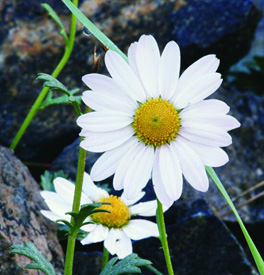 Daisies are common flowers in many parts of the world. Compare a daisy bud with an open daisy flower. See if you can find the sepals in each one.
Daisies are common flowers in many parts of the world. Compare a daisy bud with an open daisy flower. See if you can find the sepals in each one.
What Is Pollination?
Pollination is the movement of pollen from the anther to the stigma. This is how plants reproduce. For a plant to reproduce, the pollen and the egg must meet. It is best if they come from different plants. This makes sure the offspring are strong and healthy.
Animal-Pollinated Plants
Some plants are pollinated by animals. These plants have brightly colored petals. They also have sweet-smelling nectar. The color and smell attract birds, insects, and some animals to the flower. They feed on the nectar. They move into the flower to reach the nectar. Pollen brushes onto their bodies. Next they move off to feed from another flower. They carry the pollen with them. The pollen brushes off onto the stigma of another plant.
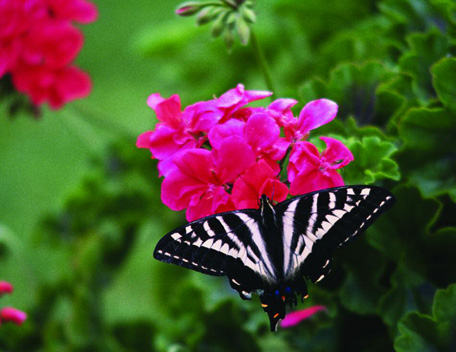 Butterflies can see well. They are attracted to brightly colored petals, especially red petals.
Butterflies can see well. They are attracted to brightly colored petals, especially red petals.
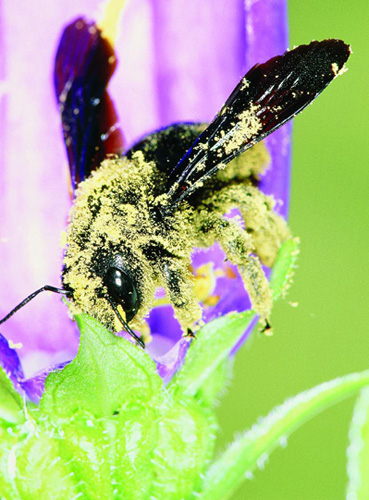 This bee is completely covered in yellow, sticky pollen.
This bee is completely covered in yellow, sticky pollen.
Wind-Pollinated Plants
Other plants are pollinated by the wind. These plants have long stamens. The stamens hang outside of the flower. Wind blows the pollen off the anthers. The pollen blows around in the air. Some of the pollen will eventually be carried to the stigma of another plant.
What Are the Differences Between Animal- and Wind-Pollinated Plants?
This table shows the main differences:
| Animal-Pollinated Plants | Wind-Pollinated Plants |
|---|---|
| Pollen is sticky and heavy. | Pollen is smooth and light. |
| Petals are brightly colored. | Petals may be dull or not present at all. |
| Stamens are inside the flower. | Stamens hang outside the flower. |
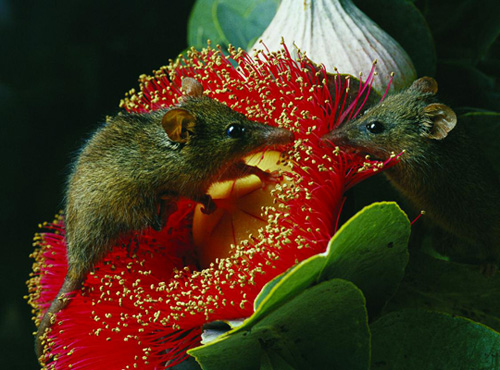 Not only insects feed from flowers. These Australian honey possums are feeding from this flower. They may transfer pollen to the next flower they visit.
Not only insects feed from flowers. These Australian honey possums are feeding from this flower. They may transfer pollen to the next flower they visit.
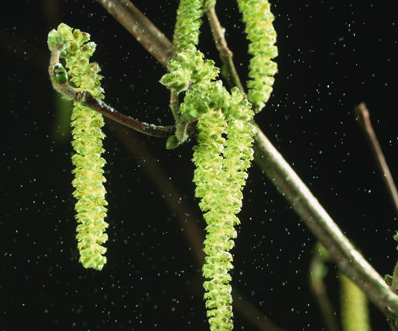 This hazel tree is wind pollinated. You can see the pollen blowing around in the wind.
This hazel tree is wind pollinated. You can see the pollen blowing around in the wind.
What is Fertilization?
Once the pollen lands on the stigma, it must find the eggs. The pollen grows a tube. The tube travels down the style and into the ovary. The ovary contains the eggs. Part of the pollen travels down the tube to the eggs. When the male pollen and the female egg meet, fertilization takes place. Fertilization is the joining of the pollen and the egg. Fertilization forms a seed. Seeds contain everything they need to grow into a new plant.
LONG-TONGUED BATS
Bats can pollinate flowers, too. They drink the sugary nectar and eat pollen. The tube lipped bat, from Ecuador, has a record-breaking tongue. It can extend its tongue to 1.5 times its body length. This helps the bat reach into trumpet-shaped flowers. Imagine your tongue were that long. It would be over six feet (2 m) long!
Additional topics
- ALL ABOUT SEEDS - How Do Seeds Find a Good Place to Grow?, 1. Wind Dispersal
- PLANT TRANSPORT - Xylem, Phloem, Roots and Stems
- Other Free Encyclopedias